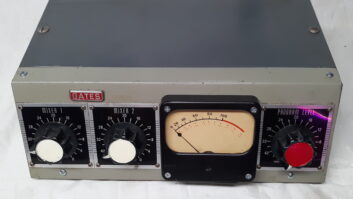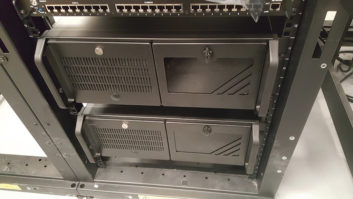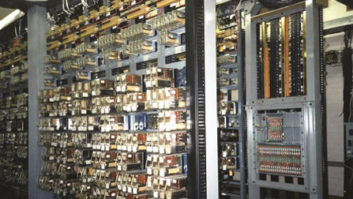Transmitter site essentials
Jun 1, 2002 12:00 PM, By Mark Krieger, CBT
Transmitter facilities hold a special fascination for radio engineers. Ranging from spotless high-rise suites to dirt road shacks, the “site” as is it’s known in the professional vernacular, represents a station’s final, vital link to the listener. Consequently, it sometimes also serves as a repository for an engineer’s blood, sweat and tears � so let’s take a closer look at what it takes to maintain a safe and efficient operation at these mission-critical installations.
Documentation
Thorough and up-to-date documentation are fundamental to maintaining a robust transmission facility. Because the location serves as a control point during maintenance, copies of all current FCC licenses and authorizations, including chief operator designations and tower registrations, are required. But the legal obligations don’t end there. OSHA regulations generally require a written, up-to-date lock-out/tag-out policy for all hard-wired, electrically powered equipment, along with approved locking devices and tags. Document in detail any areas (including areas on towers) that constitute a non-ionizing (RF) radiation occupational exposure hazard, as well as a policy regarding access and exposure limitations. Being a lessee at a site does not relieve you of any of these obligations � check with the owners to see if a master site plan exists. If not, work together to develop one.
Equipment data such as manuals and schematics should be maintained on site for all essential systems. In addition, keep a list of essential phone numbers, including hot lines and key personnel along with local FAA, utility and safety service contacts. Attach a list of all telco circuit designators and the associated trouble reporting numbers.
While most contract engineers carry their own tools, the transmitter site should be stocked with some basic items.

If you had to call for police, paramedic or fire help, would they know how to find your facility? Contact representatives from all local safety services to make them aware of exactly who, what and where the facility is located. The difference in response time might save a life.
Keep detailed records. Although, the FCC lifted requirements for an official maintenance log years ago, keeping an organized, detailed, running account of all operating parameters, equipment installation, maintenance, outages and discrepancies is absolutely vital to the operation. Keep your FCC-mandated quarterly tower inspection among these documents and maintain them for a minimum of two years � they represent an irreplaceable information resource.
In addition to written records, a comprehensive flow chart/block diagram of the entire air chain, complete with all remote control switching functions, is an invaluable trouble-shooting aid, on-site and off, particularly when you are maintaining multiple transmitter sites.
Tools and technology
The question of how many and what type of tools to maintain at a transmitter site is an interesting one. Most contract engineers I know rarely set foot out of the house without their tools, so the need for an on-site inventory is partially diminished. Still, it’s a good idea to have a minimum compliment of screwdrivers, pliers, wire cutters, adjustable wrenches, socket wrenches, hex keys and soldering aids on site. Also, any large or specialized tools such as vises, fuse pullers, pulley removers or pry bars should be available, along with a reliable trouble lamp and spare bulbs. This need not be an expensive proposition. Keep a shopping list for each site and pick up tools on sale (or used tools) until the desired inventory is built. Done this way, a minimal investment of $100 can yield a useful selection.
Likewise, a minimal stash of fasteners, particularly #4 through �” machine screws, washers and nuts are a cost-effective investment, particularly when one disappears down a crack at 3 a.m. Premium electrical and duct tape are equally indispensable.
A reliable DMM with appropriate test leads and spare batteries should be kept at a transmitter site.

The characteristics of any maintained electronic parts inventory depends largely on your equipment, its history and the available budget. Full sets of spare tubes and fuses are a must, but your own experience with each piece of equipment will tell you a great deal about which other specialized and non-specialized electronic components to maintain. Equipment redundancy will also impact your parts inventory needs.
As for test equipment, this is again a case of what the budget will bear. At minimum, a reliable DMM, with multiple test leads and spare batteries should be present. An oscilloscope is a nice option, but should be kept in a protective case and tested periodically. Telephone butt sets and volt pens are also useful.
Finally, don’t overlook cleaning supplies and chemicals. Straight isopropyl alcohol is a good cleaning agent for inside transmitters when teamed with lint-free shop towels. Spray contact cleaners are a key item, as are cleaning swabs and toothbrushes. Of particular merit is a shop-vac; a bulky item, but it will be used regularly.
Safety considerations
Safety is paramount at every transmitter facility. Items that should be readily accessible when you walk through the door are a flashlight with spare batteries and a recently inspected fire extinguisher. Once inside, there should be an obvious place for a hard hat, safety gloves, goggles and kneepads. If you have a generator, hearing protectors are also a must. Additional site keys for gates and buildings should be clearly tagged and hung together in an easy-to-see location. Safety signs and notices should be posted wherever they are required.
As a final cautionary note, try to appreciate the critical need for having a buddy � anyone capable of watching you and able to call for help whenever you have to open energized or disconnected high-voltage equipment. Your life, and the people that depend on you, hang in the balance.
Backing up the back-ups
There is one last item worth considering for your site. An ISDN circuit carries a low monthly maintenance fee, can be used for POTS communications (with an ISDN phone) and also provides a potential air-quality link to any location in the outside world, should an STL path be disrupted or a studio facility be rendered unusable due to fire or other disaster. If you don’t own an ISDN codec, find someone locally who does and forge a loan agreement in the event of an emergency. Better yet, work out a reciprocal agreement for sharing studio or transmitter facilities should the worst occur.
Krieger, BE Radio’s consultant on contract engineering, is based in Cleveland and can be reached at[email protected].








